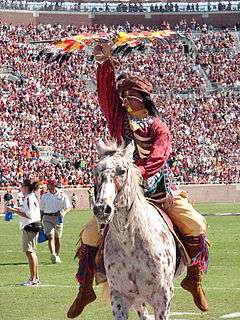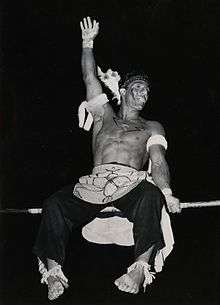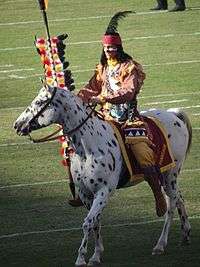Osceola and Renegade

Osceola and Renegade are the official mascots of the Florida State University Seminoles. Osceola, representing the historical Seminole leader Osceola, and his Appaloosa horse Renegade introduce home football games by riding to midfield with a burning spear and planting it in the turf.
Osceola and Renegade debuted in 1978, and are the most recent of several mascots used by the school. FSU has tried to ensure a dignified depiction of Osceola. The portrayal is supported by leaders of the Seminole Tribe of Florida, but it remains controversial in some quarters.
Depiction
Florida State's Osceola tradition is overseen by Allen Durham, whose father, Bill Durham, introduced it in 1978.[1] Osceola wears a Native American-themed costume that the university says was "designed and approved by the Seminole Tribe of Florida," consisting of leather clothing, moccasins, face paint, and a garnet bandana.[2] He carries a feathered spear and is accompanied by Renegade, an appaloosa horse whom he rides bareback. Osceola performs at all home football games at Doak Campbell Stadium and related events like Homecoming. He initiates each game by charging Renegade to midfield and hurling a flaming spear into the ground.[3][4]
The Durham family personally selects and trains both the rider and horse, and it coordinates the tradition with oversight by the university. Students portraying Osceola must undertake a two-year apprenticeship, demonstrate necessary riding skill for the role as well as moral character and maintain a grade-point average of 3.0. Students receive a scholarship for portraying Osceola and are required to remain in character and abide by a set of protocols throughout all performances. There is only one Osceola impersonator at a time; as of 2014 sixteen students have played the role, with the sixteenth rider currently serving.[3][5]
History

Previous mascots
Florida State University adopted the Seminoles nickname in 1947, just after its reorganization from a women's college to a coed institution. The moniker was selected through a fan competition; reportedly the newly established football team liked it so much that they stuffed the ballot box to ensure its selection.[6] Prior to the introduction of Osceola and Renegade, the Florida State Seminoles used several different Native American-themed mascots. The first was Sammy Seminole, introduced at the FSU Pow Wow in 1958 for football games. This mascot was portrayed by a white male member of the gymnastics or circus programs, who performed wild stunts in garish faux-Native American garb. The gymnastics program's sponsorship of Sammy Seminole ended in 1968, but the character was quickly reintroduced.[7]
In the late 1960s Chief Fullabull emerged as a mascot during basketball games. Like Sammy Seminole, he donned cartoonish Native American-themed outfits, and performed clownish stunts. Under protest from Native American groups, the character's name was altered to Chief Wampumstompum, though this did nothing to assuage the concerns of protesters. The character was replaced with a more traditionally dressed figure named Yahola, also known as the "spirit chief". All of these mascots were eventually retired, and officials decided to find a more respectful representative for the school's teams.[5][8]

Development of Osceola
The Osceola and Renegade mascots were conceived by Bill Durham, a Tallahassee businessman and Florida State alumnus. He came up with the concept of a horseback-riding Seminole mascot as early as 1962, when he was voted into the school's homecoming court. He returned to the idea in 1977, and won the support of Ann Bowden, wife of head football coach Bobby Bowden, who helped make the idea a reality.[3][5] Durham contacted the Seminole Tribe of Florida about the project, and chairman Howard Tommie had tribe members make the first costume for Osceola.[9] Durham provided the horse, while Bowden helped acquire the various permits necessary to allow a horse onto the field.[3][5]
Osceola and Renegade debuted at a September 16, 1978 game against the Oklahoma State Cowboys. They proved quite popular, and subsequently other faux-Indian traditions arose, including the "War Chant" in 1984 and the "Tomahawk Chop" shortly after.[10] Durham oversaw the Osceola tradition for 25 years, and over time aspects of the performance have become more refined and regulated. In 2002, Durham retired and passed his role on to his son Allen Durham, a former Osceola portrayer.[1][3]
In the 1980s and 1990s, when mascots based on Native Americans became more controversial and many Native Americans and supporters protested their use, Florida State consulted with the Seminole Tribe of Florida, emphasizing that Osceola was never intended to be demeaning. Several representatives of the Seminole Tribe, including Chairman James E. Billie and Council Member Max Osceola, have given FSU their blessing to use Osceola and Seminole imagery.[11][12] However, the matter remains controversial for other Florida Seminoles, as well as members of the Seminole Tribe of Oklahoma.[5][12][13] Critics have noted a political undercurrent in the support from Florida Seminole leaders, who are heavily involved in business ventures such as Indian casinos in the state.[5] In 2005, the NCAA added FSU to a list of schools facing potential sanctions for using "hostile and abusive" Indian mascots and names; after much deliberation, the NCAA gave FSU an exemption, citing the university's relationship with the Seminole Tribe of Florida as a major factor.[12][14]
In keeping with his stoic portrayal, FSU refers to Osceola and Renegade as a "symbols" rather than mascots, and does not use them for more traditional mascot activities like cheerleading and promotions. In 2012, the university revived an older mascot, an anthropomorphic horse named "Cimarron", to fill this role.[15]
In April 2016 the FSU Student Government Association voted to ban Native American headdresses from sporting events as being contrary to the goal of maintaining its relationship with the Seminole Tribe, because the headdresses worn by fans are closer to those worn by Plains Indians. Those not complying with the ban will be deemed by the FSU Student Government Association to be in violation of the FSU student code of conduct.[16] This resolution is a purely symbolic Student Government Association act and students can still wear the headdresses without fear of disciplinary action being taken against them. [17]
Osceola through the years
- Jim Kidder (1978–1979)
- David Mays (1980–1981)
- David Williams (1982)
- Jeff Ereckson (1983–1984)
- Greg Ereckson (1985–1986)
- James Fairfield (1987–1988)
- Tom Sawyer (1989–1991)
- Allen Durham (1992–1994)
- Andy Taylor (1995–1996)
- Jason Mork (1997)
- Alumni Riders (1998)
- Daniel Kennerly (1999)
- Lincoln Golike (2000–2003)
- Josh Halley (2004–2007)
- Chris Gannon (2008)
- Drake Anderson (2009-2013)
- Brendan Carter (2014–present)
See also
Notes
- 1 2 Bayard Stern (November 2002). "Bill Durham passing torch to son after 25 years". Florida State Times. Retrieved February 26, 2013.
- ↑ King & Springwood, p. 138, 144.
- 1 2 3 4 5 King & Springwood, pp. 138–139.
- ↑ Turner Cowles (November 9, 2011). "Osceola in the making". FSU News. Retrieved February 26, 2013.
- 1 2 3 4 5 6 Rosier, p. 14.
- ↑ King & Springwood, p. 136.
- ↑ King & Springwood, p. 137.
- ↑ King & Springwood, pp. 137–138.
- ↑ Culpepper, Chuck (December 29, 2014). "Florida State's unusual bond with Seminole Tribe puts mascot debate in a different light". The Washington Post. ISSN 0190-8286. Retrieved December 31, 2015.
- ↑ King & Springwood, p. 142.
- ↑ King & Springwood, pp. 143-145.
- 1 2 3 Steve Wieberg (August 23, 2005). "NCAA allowing Florida State to use its Seminole mascot". USA Today. Retrieved March 1, 2013.
- ↑ King & Springwood, pp. 145-147.
- ↑ "Florida State Can Keep Its Seminoles". The New York Times. August 24, 2005. Retrieved March 1, 2013.
- ↑ Coley Harvey (May 1, 2012). "FSU brings back mascot Cimarron to serve at school functions". orlandosentinel.com. Retrieved February 28, 2013.
- ↑ Perry Kostidakis (May 3, 2016). "FSU SGA passes resolution banning headdresses at games". FSUNews.com.
- ↑ "FSU -ER15 -3 Student Conduct Code" (PDF). FSU Student Conduct Code. Florida State University. Retrieved September 24, 2016.
References
- King, C. Richard; Charles Fruehling Springwood (2001). Team Spirits: The Native American Mascots Controversy. University of Nebraska Press. ISBN 0803277989. Retrieved April 18, 2013.
- Bayard Stern (November 2002). "Bill Durham passing torch to son after 25 years". Florida State Times. Retrieved February 26, 2013.
- Rosier, Paul C. (2003). Native American Issues (Contemporary American Ethnic Issues). Greenwood. ISBN 0313320020. Retrieved April 18, 2013.